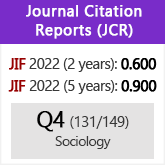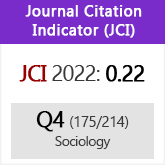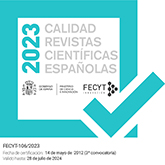Identity and behaviour of BT corn. The debate about the prediction of the potentially adverse consequences of the genetic engineering
DOI:
https://doi.org/10.3989/ris.2008.02.26Keywords:
controversies, experts, Safety, technoscience, uncertaintyAbstract
This article analyses the main causes and consequences related to the powerful scientific and technological network of the contemporary occidental societies. Specifically, it is examined the particular controversy about the creation, growing and commercialization of a transgenic corn variety which it is property of a multinational enterprise called Syngenta. In opposition to the more idealistic and metaphysical perspectives of the research practice, in this work it is proposed that the development of the research may not completely guarantee the future closure of some problems related with the present scientific and technological system. bearing in mind a more critical and reflexive point of view about the new technoscience, it is explored the dissimilar collective translations activated and mobilized here and it is investigated which particular social groups are benefited and which others are harmed by the conflict of the free global propagation of these genetically modified organisms.
Downloads
References
Alcalde, E. 1997. “Maíz autoprotegido contra el taladro”. Vida Rural. 50: 36-37.
Alcalde, E. 2000. “Compa CB . Un maíz mejorado genéticamente resistente a plagas”. Vida Rural. 7: 48-49.
APRO SE. 2006. Guía de buenas prácticas para el cultivo de maíz Bt. Madrid: Asociación Profesional de Empresas Productoras de Semillas Selectas.
Arias, M. 2000. Las plagas adquieren resistencia. Barcelona: Asociación Vida Sana.
ASA. 1999. Utilización de refugios en maíces Bt. Buenos Aires: Programa de Productividad Sustentable. Asociación de Semilleros Argentinos (ASA).
Beltrán Villalva, M. 2000. Perspectivas sociales y conocimiento. Barcelona: Anthropos.
Beriain, J. 1996. comp. Las consecuencias perversas de la modernidad. Barcelona: Anthropos.
Birch, A.N.E., I.E. Geoghegan, M. E.N. Majerus, C. Hackett y J. Allen. 1996-1997. “Interactions Between Plant Resistance Genes, Pest Aphid Populations and Beneficial Aphid Predators”. Scottish Crop Research Institute. Dundee. Annual Report. 1996-1997: 68-72.
Borlaug, N. E. 1999. “Los ecologistas extremistas impiden erradicar el hambre”. El País. 28 de octubre de 1999.
Bourdieu, P. 2003. El oficio de científico. Ciencia de la ciencia y reflexividad. Barcelona: Anagrama.
Brake, J. y D. Vlachos. 1998. “Evaluation of Transgenic Event 176 “Bt” Corn in Broiler Chickens”. Poultry Science. 77: 648-653. PMid:9603350
Collins, H. M. y T.J. Pinch. 1996. El gólem. Lo que todos deberíamos saber acerca de la ciencia. Barcelona: Crítica.
Chapela, I. 2005. “¿Quién necesita transgénicos?”. En Transgénicos, ¿quién los necesita?, A. Batra et al. comp., pp. 27-37. México: Grupo Parlamentario del Partido de la Revolución Democrática.
Chimal, C. 2002. “El dilema de los organismos transgénicos”. Avance y Perspectiva. 21: 389-401.
Dalton, R. 2001. “Transgenic Corn found Growing in Mexico”. Nature. 413: 337. doi:10.1038/35096714 PMid:11574839
Domingo Roig, J.L. 2000. “Health Risks of GM Foods. Many Opinions but Few Data”. Science. 288: 1748-1749. doi:10.1126/science.288.5472.1748 PMid:10877692
Domingo Roig, J. L. y M. Gómez Arnáiz. 2000. “Riesgos sobre la salud de los alimentos modificados genéticamente. Una revisión bibliográfica”. Revista Española de Salud Pública. 74: 255-261. PMid:10918812
EPA. 1995. Bacillus Thuringiensis Cry 1A(b) Delta-Endotoxin and the Genetic Material Necessary for its Production in Corn. Event Bt-176 for Ciba-Novartis and Mycogen. USA: Pesticide Fact Sheet. Environmental Protection Agency (EPA-OPPTS).
EPA. 2000. Informe sobre las mariposas Monarca y las plantas transgénicas Bt. USA: Scientific Advisory Panel. Environmental Protection Agency (SAP-EPA).
Goldsmith, Z. 1998. “¿Ecoguerrilleros o vándalos? ¿Quiénes son los auténticos terroristas?”. The Ecologist. 28: 62-65.
Gould, F. 1996. “Bt Cotton Infestations Renew Resistance Concerns”. Nature Biotechnology. 14: 1070. doi:10.1038/nbt0996-1070
Greenpeace. 2000. Centros de diversidad. La riqueza biológica de los cultivos tradicionales, herencia mundial amenazada por la contaminación genética. México: Greenpeace de México.
Hanson-Jesse, L. C. y J.J. Obrycki. 2000. “Field Deposition of Bt Transgenic Corn Pollen: Letal Effects on the Monarch Butterfly”. Oecologia. 125: 241-248. doi:10.1007/s004420000502
Hilbeck, A., M. Baumgartnew, P.M. Fried y F. Bigler. 1998. “Toxicity of Bacillus Thuringiensis Cry1Ab Toxin to the Predator Chrysoperla Carnea (Neuroptera. Chrisopidae)”. Environmental Entomology. 27: 1255-1263.
Ho, M-W y L.L. Ching. 2004. En defensa de un mundo sustentable sin transgénicos. Londres: Institute of Science in Society. Third World Network.
Ho, M-W. y J. Mathews. 2002. “Declaración conjunta internacional sobre el escándalo de la contaminación con maíz transgénico en México”. Ecología Política. 23: 166-170.
Iannone, N. 2001. Control químico de Diatraea. Tecnología que apunta a la alta producción. Buenos Aires: Pergamino. Instituto Nacional de Tecnología Agropecuaria (INTA)
Iranzo, J. M. y J.R. Blanco. 1999. Sociología del conocimiento científico. Madrid: CIS y UPNA .
James, C. 2005. Situación global de los cultivos transgénicos comercializados: 2005. Briefs 34. Ithaca. Nueva York: International Service for the Acquisition of Agri-Biotech Applications (ISAA) .
Lamo de Espinosa, E., J.M. González García y C. Torres Albero. 1994. La sociología del conocimiento y de la ciencia. Madrid: Alianza.
Latour, B. y S. Woolgar. 1995. La vida en el laboratorio. La construcción de los hechos científicos. Madrid: Alianza.
Liu, Y-B., B.E. Tabashnik, T.J. Denneby, A.L. Patin y A.C. Barlett. 1999. “Development Time and Resistance to Bt Crops”. Nature. 400: 519. doi:10.1038/22919 PMid:10448853
López Cerezo, J. A. y J.L. Luján López. 2000. Ciencia y política del riesgo. Madrid: Alianza.
Losey, J. E., L.S. Rayor y M.E. Carter. 1999. “Transgenic Pollen Harms Monarch Larvae”. Nature. 399: 214. doi:10.1038/20338 PMid:10353241
Mármol, E. 2002. “Impacto ocasionado por el uso de maíz en las fincas de España”. Vida Rural. 9: 32-34.
Martínez, G. 1997. “Panorámica general del cultivo del maíz”. Vida Rural. 53: 49-51.
Mendiola, I. 2006. El jardín biotecnológico. Tecnociencia, transgénicos y biopolítica. Madrid: La Catarata.
Muñoz Ruiz, E. 2002. “Los medios de comunicación y los alimentos modificados genéticamente. Conflicto entre conocimiento e información”. IESA-CSIC. Documento de Trabajo 02-11.
Novillo Almendros, C. 2006. “Buenas prácticas con el maíz Bt para asegurar sus beneficios en el futuro”. Agricultura: Revista Agropecuaria. 75: 222-223.
Obrycki, J. J., J.E. Losey, O.R. Taylor y L.C. Hanson-Jesse. 2001. “Transgenic Insecticidal Corn: Beyond Insecticidal Toxicity to Ecological Complexity”. BioScience. 51: 353-361. doi:10.1641/0006-3568(2001)051[0353:TICBIT]2.0.CO;2
Pacheco-Vega, H. R. y O. Vega-López. 2001. “La controversia de la mariposa Monarca. Un análisis a la luz de las teorías sociales del riesgo”. Convergencia. 26: 145-169.
Peinado, D. 1999. “Transgénicos. ¿Alimentos que matan o remedio contra el hambre?”. El Semanal. pp. 34-46.
Popper, K. R. 1962. La lógica de la investigación científica. Madrid: Tecnos.
Quist, D. y I. Chapela 2001. “Transgenic DNA Introgressed into Traditional Maize Landraces in Oaxaca, Mexico”. Nature. 414: 541-543. doi:10.1038/35107068 PMid:11734853
Ramos Torre, R. 2002. “El retorno de Casandra. Modernización ecológica, precaución e incertidumbre”. En ¿Más allá de la modernidad?, García Blanco, J. Mª. y P. Navarro Sustaeta, comps., pp. 403-455. Madrid: CIS.
Red en Defensa del Maíz. 2003. La contaminación transgénica del maíz campesino en México. México, CECA M, CENA MI, Grupo ETC, CA SIFO P, UNO SJO y AJAGI.
Riechmann, J. y J. Tickner. 2002. eds., El principio de precaución en medio ambiente y salud pública. De las definiciones a la práctica. Barcelona: Icaria.
Sampedro, J. 1999. “Los transgénicos, a la luz de los argumentos”. El País. 7 de diciembre de 1999.
Saxena, D., Flores, S. y Stotzky, G. 1999. “Transgenic Plants: Insecticidal Toxin in Roots Exudates from Bt Corn”. Nature. 402: 430-431.
Sears, M. K., et al. 2001. “Impact of Bt Corn Pollen on Monarch Butterfly Populations. A Risk Assessment”. Proceedings of the National Academy of Sciences. 98: 11.937-11.942.
Sentís Castaño, C. 2002. “Ingeniería genética. Insuficiencias teóricas y la aplicación del principio de precaución”. Política y Sociedad. 39: 627-639.
Silva Castro, C. A. 2005. Maíz genéticamente modificado. Bogotá. Colombia: AGRO -BIO.
Spendeler, L. y J.F. Carrasco. 2003. Al grano. Impacto del maíz transgénico en España. Amigos de la Tierra y Greenpeace. Alcobendas: Industrias Gráficas EPES.
Seeds, S. 1997. El maíz sigue siendo maíz. ¿Por qué necesitamos la tecnología genética? Basilea: Syngenta Seeds.
Tabashnik, B.E. 1994. “Evolution of Resistance to Bacillus Thuringiensis”. Annual Review of Entomology. 39: 47-49. doi:10.1146/annurev.en.39.010194.000403
Tabashnik, B.E., et al. 1997. “One Gene in Diamondback Moth Confers Resistance to Four Bt Toxins”. Proceedings of the National Academy of Sciences. (USA). 94: 1640-1644. doi:10.1073/pnas.94.5.1640
Wolfenbarger, L. L. y P.R. Phifer. 2000. “The Ecological Risks and Benefits of Genetically Engineered Plants”. Science. 290: 2088-2092. doi:10.1126/science.290.5499.2088 PMid:11118136
Wynne, B. 1997. “Incertidumbre y aprendizaje ambiental. Reconcebir la ciencia y la política en un paradigma preventivo”. En Ciencia, tecnología y sociedad. Lecturas seleccionadas. González García, M. I., J.A. López Cerezo y J.L. Luján López. 1997. pp. 161-183. Barcelona: Ariel.
Downloads
Published
How to Cite
Issue
Section
License
Copyright (c) 2010 Consejo Superior de Investigaciones Científicas (CSIC)

This work is licensed under a Creative Commons Attribution 4.0 International License.
© CSIC. Manuscripts published in both the printed and online versions of this Journal are the property of Consejo Superior de Investigaciones Científicas, and quoting this source is a requirement for any partial or full reproduction.All contents of this electronic edition, except where otherwise noted, are distributed under a “Creative Commons Attribution 4.0 International” (CC BY 4.0) License. You may read here the basic information and the legal text of the license. The indication of the CC BY 4.0 License must be expressly stated in this way when necessary.
Self-archiving in repositories, personal webpages or similar, of any version other than the published by the Editor, is not allowed.

















